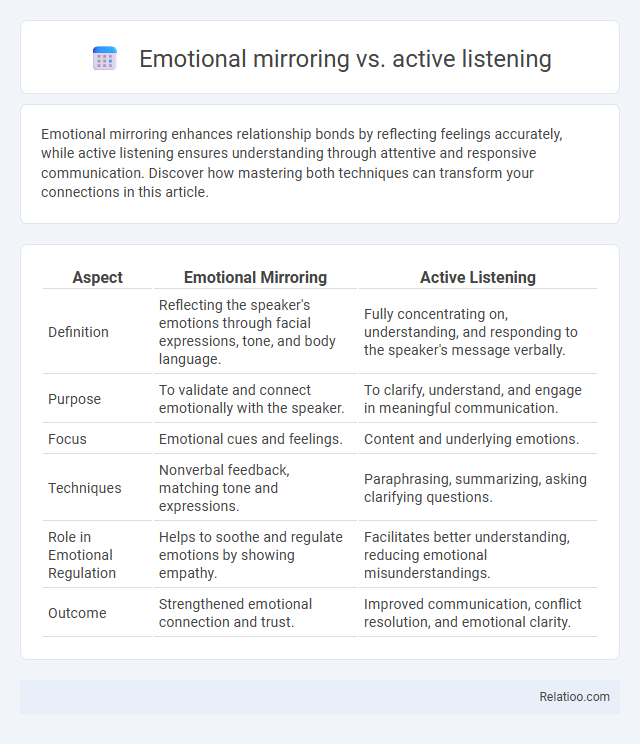Emotional mirroring enhances relationship bonds by reflecting feelings accurately, while active listening ensures understanding through attentive and responsive communication. Discover how mastering both techniques can transform your connections in this article.
Table of Comparison
| Aspect | Emotional Mirroring | Active Listening |
|---|---|---|
| Definition | Reflecting the speaker's emotions through facial expressions, tone, and body language. | Fully concentrating on, understanding, and responding to the speaker's message verbally. |
| Purpose | To validate and connect emotionally with the speaker. | To clarify, understand, and engage in meaningful communication. |
| Focus | Emotional cues and feelings. | Content and underlying emotions. |
| Techniques | Nonverbal feedback, matching tone and expressions. | Paraphrasing, summarizing, asking clarifying questions. |
| Role in Emotional Regulation | Helps to soothe and regulate emotions by showing empathy. | Facilitates better understanding, reducing emotional misunderstandings. |
| Outcome | Strengthened emotional connection and trust. | Improved communication, conflict resolution, and emotional clarity. |
Understanding Emotional Mirroring
Emotional mirroring involves reflecting another person's feelings and expressions to validate their emotional experience, which strengthens empathy and connection in communication. Unlike active listening that emphasizes attentive hearing and responding to verbal content, emotional mirroring specifically targets nonverbal cues to create emotional resonance. Understanding emotional mirroring is crucial for enhancing interpersonal relationships, as it fosters trust and emotional support by synchronizing emotional states between individuals.
What is Active Listening?
Active listening is a communication technique that involves fully concentrating, understanding, responding, and remembering what is being said in a conversation. It requires your complete attention to the speaker's words, tone, and body language, ensuring empathy and clarity in the exchange. Unlike emotional mirroring, which focuses on reflecting emotions, active listening emphasizes understanding content and intent to build trust and effective dialogue.
Core Principles of Emotional Mirroring
Emotional mirroring centers on reflecting another person's feelings through empathetic body language and verbal cues to validate their emotional experience, fostering connection and trust. Unlike active listening, which emphasizes attentively processing and responding to content, emotional mirroring prioritizes nonverbal synchronization and emotional resonance to create psychological safety. Core principles include authentic empathy, attentive observation of emotional signals, and subtle mimicry to enhance rapport and deepen interpersonal understanding.
Key Components of Active Listening
Active listening emphasizes key components such as maintaining eye contact, providing verbal affirmations, and reflecting on the speaker's message to ensure understanding. Your ability to focus on non-verbal cues and avoid interrupting enhances emotional connection and trust during conversations. Emotional mirroring differs by primarily involving matching the speaker's emotions to validate feelings rather than fully processing the content as active listening requires.
Emotional Mirroring: Benefits and Applications
Emotional mirroring involves reflecting another person's feelings through body language, facial expressions, and tone, fostering empathy and trust in communication. This technique benefits relationships by validating emotions, enhancing emotional intelligence, and reducing conflict, particularly in therapy and counseling settings. Applications of emotional mirroring extend to leadership, customer service, and conflict resolution, where understanding and responding to emotional cues improve cooperation and connection.
Active Listening: Enhancing Communication
Active listening enhances communication by fully concentrating, understanding, and responding thoughtfully to the speaker, which fosters trust and clarity in conversations. Unlike emotional mirroring, which involves reflecting the speaker's feelings to create empathy, active listening focuses on verbal and non-verbal feedback to confirm comprehension and encourage openness. This skill is essential in strengthening interpersonal relationships and resolving conflicts effectively in both personal and professional contexts.
Emotional Mirroring vs Active Listening: Key Differences
Emotional mirroring involves reflecting the speaker's emotions through body language and facial expressions to create empathy and validate feelings, whereas active listening focuses on fully concentrating, understanding, and responding thoughtfully to the speaker's message. Emotional mirroring emphasizes nonverbal cues and emotional connection, while active listening prioritizes verbal feedback, paraphrasing, and clarifying questions. Both techniques enhance communication but differ in their primary approach--emotional mirroring targets emotional resonance, and active listening targets cognitive comprehension.
When to Use Emotional Mirroring in Relationships
Emotional mirroring is most effective when your partner needs validation and emotional understanding, as it involves reflecting their feelings to create empathy and connection. Active listening focuses on fully concentrating, understanding, and responding thoughtfully, which is ideal during problem-solving or serious discussions. You should use emotional mirroring in relationships to strengthen emotional bonds and provide reassurance during moments of distress or vulnerability.
When Active Listening is Most Effective
Active listening is most effective when your goal is to fully understand the speaker's message, requiring focused attention, paraphrasing, and asking clarifying questions. Unlike emotional mirroring, which primarily reflects and validates feelings to build empathy, active listening ensures accurate communication and problem-solving in conversations. You enhance trust and collaboration by using active listening in situations demanding clear comprehension and thoughtful feedback.
Integrating Emotional Mirroring and Active Listening for Better Connections
Integrating emotional mirroring and active listening enhances your ability to build deeper, more empathetic connections by reflecting both feelings and words accurately. Emotional mirroring captures the listener's ability to subtly replicate the speaker's emotions, while active listening requires fully concentrating and responding appropriately to verbal communication. Combining these techniques allows you to validate emotions effectively and respond thoughtfully, fostering trust and understanding in personal and professional relationships.

Infographic: Emotional mirroring vs Active listening
 relatioo.com
relatioo.com